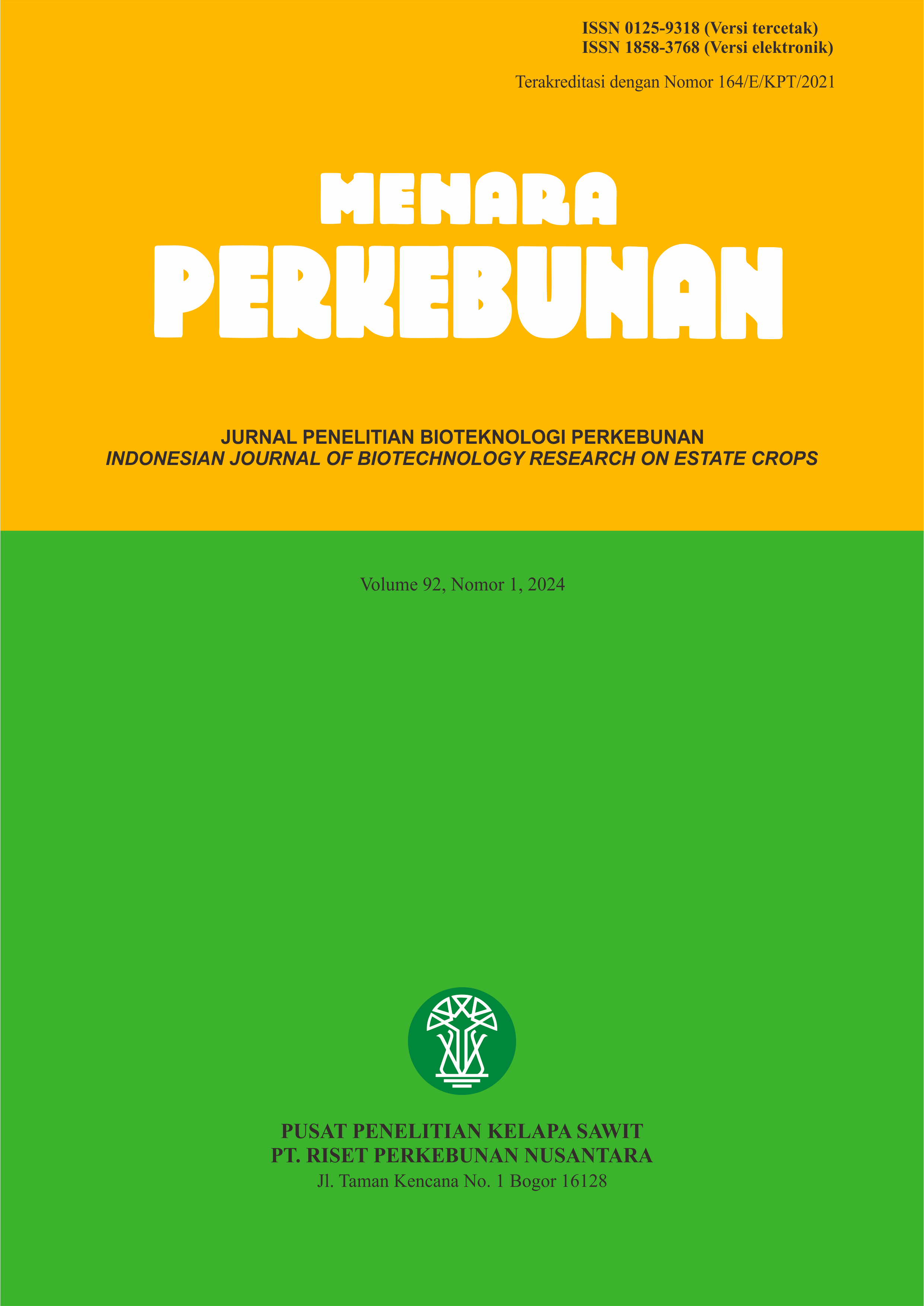Fabrication and characterization of biocomposite pellets from cassava starch and oil palm empty fruit bunch fibers
DOI:
https://doi.org/10.22302/iribb.jur.mp.v92i1.566Keywords:
Cassava starch, compounding, density, twin screw extruderAbstract
Oil palm empty fruit bunches (OPEFB) are lignocellulosic biomass that can be used to produce a biocomposite as an alternative to substitute non-renewable materials, such as plastic. Generally, the production of biocomposites uses OPEFB, which has been processed into cellulose, microcrystalline cellulose, or nanocellulose and is mixed with starch. However, the OPEFB pretreatment into various types of cellulose requires a long process and many chemicals. The OPEFB pretreatment with less process, such as cutting to shorter fibers and without chemicals, was expected to shorten the process. This study aims to produce and evaluate the characteristics of biocomposite pellets from a combination of cassava starch and OPEFB fibers. Short OPEFB fibers (3-5 mm) with varying concentrations of 0, 5, 10, 15, and 20% were added to the cassava starch before mixing with other materials. The twin screw extruder used to produce biocomposite pellets was set at six temperature zones ranging from 85-140 °C and the screw speed in the range of 160-190 rpm. The results show that higher concentrations of OPEFB fibers produced darker pellets, which tended to be greyish. The biocomposite pellets had densities of 1.322-1.417 g cm-3. SEM results show some agglomerations on the surface of starch-OPEFB fibers biocomposite pellets. The water solubility of biocomposite pellets ranged from 32.97 – 36.44%. In conclusion, biocomposite pellets could be produced from a mixture of cassava starch and OPEFB fibers up to 20%. In its application for rigid packaging production, the biocomposite pellets’ performance could be improved by mixing them with recycled polypropylene.
Downloads
References
Bharath, K. N., & Basavarajappa, S. (2016). Applications of biocomposite materials based on natural fibers from renewable resources: A review. In Science and Engineering of Composite Materials (Vol. 23, Issue 2, pp. 123–133). Walter de Gruyter GmbH. https://doi.org/10.1515/secm-2014-0088
Bhardwaj, A., Alam, T., Sharma, V., Alam, M. S., Hamid, H., & Deshwal, G. K. (2020). Lignocellulosic Agricultural Biomass as a Biodegradable and Eco-friendly Alternative for Polymer-Based Food Packaging. Journal of Packaging Technology and Research, 4(2), 205–216. https://doi.org/10.1007/s41783-020-00089-7
Chang, S. H. (2014). An overview of empty fruit bunch from oil palm as feedstock for bio-oil production. In Biomass and Bioenergy (Vol. 62, pp. 174–181). https://doi.org/10.1016/j.biombioe.2014.01.002
Cheng, T. S., Uy Lan, D. N., Phillips, S., & Tran, L. Q. N. (2019). Characteristics of oil palm empty fruit bunch fiber and mechanical properties of its unidirectional composites. Polymer Composites, 40(3), 1158–1164. https://doi.org/10.1002/pc.24824
Derman, E., Abdulla, R., Marbawi, H., & Sabullah, M. K. (2018). Oil palm empty fruit bunches as a promising feedstock for bioethanol production in Malaysia. In Renewable Energy (Vol. 129, pp. 285–298). Elsevier Ltd. https://doi.org/10.1016/j.renene.2018.06.003
Gajula, S., Antonyraj, C. A., Odaneth, A. A., & Srinivasan, K. (2019). A consolidated road map for economically gainful efficient utilization of agro-wastes for eco-friendly products. Biofuels, Bioproducts and Biorefining, 13(4), 899–911. https://doi.org/10.1002/bbb.1988
Hairani, N., Harahap, H., Herawan, T., & Taslim. (2015). The Effect of Glycerol and Oil Palm Empty Fruit Bunches Microcrystalline Cellulose Loading on Tensile Properties and Water Absorption of Cassava Starch Composite. Advanced Materials Research, 1123, 151–154. https://doi.org/10.4028/www.scientific.net/amr.1123.151
Hambali, E., & Rivai, M. (2017). The Potential of Palm Oil Waste Biomass in Indonesia in 2020 and 2030. IOP Conference Series: Earth and Environmental Science, 65(1). https://doi.org/10.1088/1755-1315/65/1/012050
Isroi, Cifriadi, A., Panji, T., Wibowo, N. A., & Syamsu, K. (2017). Bioplastic production from cellulose of oil palm empty fruit bunch. IOP Conference Series: Earth and Environmental Science, 65(1). https://doi.org/10.1088/1755-1315/65/1/012011
Marichelvam, M. K., Jawaid, M., & Asim, M. (2019). Corn and rice starch-based bio-plastics as alternative packaging materials. Fibers, 7(4). https://doi.org/10.3390/fib7040032
Mohammad Padzil, F. N., Lee, S. H., Ainun, Z. M. A. ari, Lee, C. H., & Abdullah, L. C. (2020). Potential of oil palm empty fruit bunch resources in nanocellulose hydrogel production for versatile applications: A review. In Materials (Vol. 13, Issue 5). MDPI AG. https://doi.org/10.3390/ma13051245
Perera, U. P., Foo, M. L., Mei, I., & Chew, L. (2022). Application of nanolignin and nanocrystalline cellulose isolated from palm oil empty fruit bunch as reinforcing agents in starch biocomposite. Journal of Oil Palm, Environment & Health, 13, 1–12. https://doi.org/10.5366/jope.2022.01
Rama Rao, P., & Ramakrishna, G. (2022). Oil palm empty fruit bunch fiber: surface morphology, treatment, and suitability as reinforcement in cement composites- A state of the art review. In Cleaner Materials (Vol. 6). Elsevier Ltd. https://doi.org/10.1016/j.clema.2022.100144
Sari, L. N., Madusari, S., & Sari, V. I. (2022). Application of oil palm empty bunches as organic mulch in oil palm plantation ( Elaeis guineensis Jacq.): An evaluation and SWOT analysis. IOP Conference Series: Earth and Environmental Science, 1041(1). https://doi.org/10.1088/1755-1315/1041/1/012053
Downloads
Submitted
Accepted
Published
How to Cite
Issue
Section
License
Copyright (c) 2024 Yora Faramitha, Firda Dimawarnita, Adi Cifriadi, Happy Widiastuti, Tjahjono Herawan

This work is licensed under a Creative Commons Attribution 4.0 International License.
Authors retain copyright and grant the journal right of first publication with the work simultaneously licensed under a Creative Commons Attribution License that allows others to share the work with an acknowledgement of the work's authorship and initial publication in this journal.













